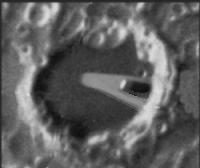The Longomontanus Lunar Ray Reports
Observer: Tony Donnangelo
Date/time of observation: 2003/12/03 06:00 U.T.
Site location: Hummelstown RD 3, PA, USA (40.26° N., 76.75° W.)
Site elevation: 479 feet (146 meters)
Site classification: Suburban
Instrument: Takahashi FS-102 f/8
Magnification: 273x
Object: Longomontanus
I started my observing session at 01:00 U.T. The temperature was 29° with a wind-chill factor of 19°. It was clear and fairly transparent early in the evening. A few small cumulous clouds were moving through the area. By 04:45 U.T., sky conditions deteriorated. The moon was getting low in the west (setting time was 07:05 U.T.), and a fast moving, high, thin cloud layer caused a hazy appearance around the moon.
Several hours before the predicted time of the ray’s occurrence, I was observing other rays that were already in progress. I kept a close watch on Longomontanus. At 04:55 U.T., the central peak was illuminated. There was a small illuminated area towards the northwest interior of the crater where numerous younger craters are superimposed over the wall of Longomontanus.
At 05:43 U.T., I went inside to warm up. No ray was occurring at that time. At 06:00 U.T. (only three minutes from the predicted time of occurrence), I observed a very narrow shaft of light extending from slightly west of the central peak to the patch of light observed earlier.
By 06:15 U.T., I wasn’t able to make any further lunar observations. It became cloudier, and the moon began setting behind a tree.
 |
Date: 01-23-02
Time: 2:00 UT-5:00 UT
Location: Bonner Springs KS, 94.8932W, 39.0579N
Seeing: 7 of 10; Transparency 7 of 10
Instrument: 8" f7 Starmaster; 89x & 112x
Some ground hazing but not obstructive to viewing.
Watched Longomontanus continuously over a period starting at around
2:00 UT, since was also timing total occultations. At around 3:30 UT I
began a constant watch on the crater, and slowly saw develop a broad shaft
of light. By 4:30 UT it was stretching 3/4 the way across the floor of the
crater. It was interesting to watch before hand the tips of peaks along the crater rim, being illuminated by the sunlit. Saw 4-5 tiny star-like points along the western wall. The small peak on the west end was also being illuminated before the ray started to develop, and the shadow seemed to appear slightly blacker than the floor of the crater. Could the floor have been illuminated by light reflecting off the interior walls of the crater? Rendition to the left was done at 4:30 UT. By the time I ended the observation, it had spread out in width, and the shadow took on a distinctive "C" shape.Ended observation at 5:00 UT |
